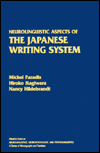METAMAPS. Vol. II, No. 1. (p. 4). March 1994.
BOOK REVIEW:
Neurolinguistic Aspects of the Japanese Writing System
by Michel Paradis, Hiroko Hagiwara, and Nancy Hildrebrandt
Orlando, Florida: Academic Press (1985)

This book explores the connection between the way the brain functions and how written language is perceived. Disparities between the way that Japanese kana and kanji are processed is one of the main themes of this text. Since the Japanese writing system uses three – or arguably four – different scripts with both phonetic and ideographic components, it is an excellent chance to understand the interaction between reading and writing.
The most interesting part of this book is its description of how dyslexics process textual information differently from other readers. Citing Marshall's (1982) study of dyslexic and non-dyslexic readers, the authors suggest that most Japanese readers use a variety of text processing strategies. Dyslexics, by contrast, appear to have a narrow repertory of only one or two strategies.
This work also provides a comprehensive description of the Japanese writing system. Contrasting ideographic characters with those which are semantically opaque, they cite evidence suggesting most people tend to use their left visual field when encountering complex kanji and their right visual field when viewing phonetic characters or simple kanji.
Borrowing ideas from clinical psychology, the authors use the term "dissasociation" to describe a gap in the way that different characters are read. The most common form of disassociation among Japanese readers occurs when kanji reading skills remain intact, but kana reading skills are impaired. This impairment is frequently noted in those with injuries to their left temporal cortex. Kanji reading impairment tends to occur among those with left occipito-parietal cortical injuries. Interestingly, right hemisphere injuries do not seem to have much effect on kana or kanji processing.
This text raises more questions than it answers. One of the most fascinating questions it raised was the extent that kana and kanji processing differ. Another interesting point was when meaning becomes "mapped" onto a conscious representational system.
The strength of this work is in its overview of the research on Japanese reading processes. Its main weakness is that it doesn't quite offer any
convincing model of how written language is processed. The authors were more successful at criticizing existing research on language processing
than in offer new ideas of how the mind handles written information.
Reviewed by Tim Newfields
Marshall, J. C. (1982, March). Taxonomies of dyslexia. Lecture presented at the Montreal Neurological Institute, McGill University.